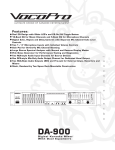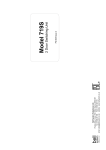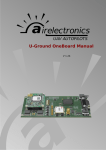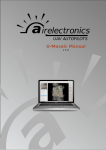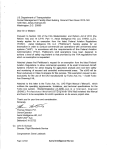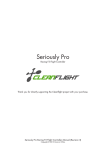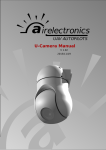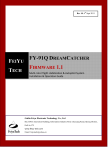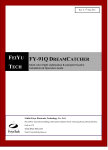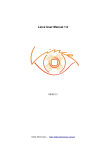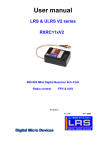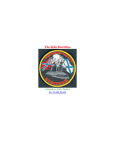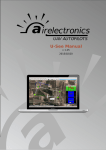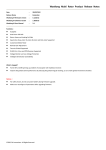Download 3 U-Pilot OEM51 - Airelectronics
Transcript
V 0.6 U- Pilot OEM51 User Manual - Table of Contents 1 General System Introduction.............................................................................................3 1.1 Concept of system operation......................................................................................4 2 Controllable Air vehicles.....................................................................................................5 2.1 Fixed wing...................................................................................................................5 2.1.1 Conventional configuration fixed wing.................................................................5 2.1.2 Flying wing configuration.....................................................................................5 2.2 Rotary wing.................................................................................................................5 2.2.1 Helicopter (Swash-plate 4)..................................................................................5 2.2.2 Helicopter (Swash-plate 3)..................................................................................5 2.2.3 Helicopter (Direct Drive)......................................................................................6 2.2.4 Quadcopter..........................................................................................................6 2.2.5 Hexacopter..........................................................................................................6 2.2.6 Octocopter...........................................................................................................7 3 U-Pilot OEM51...................................................................................................................8 3.1 Power supply..............................................................................................................8 3.2 Monitoring Engine Data..............................................................................................9 3.3 Microprocessors structure..........................................................................................9 3.4 Sensors.......................................................................................................................9 3.5 U-Pilot OEM51 Connections.....................................................................................11 3.6 Magnetometer connections......................................................................................14 Appendix A Guide for determining servo reverse................................................................15 Fixed Wing servos...........................................................................................................15 Helicopter Servos............................................................................................................15 Direct Servos...............................................................................................................15 Swash-plate 4..............................................................................................................16 Swash-plate 3..............................................................................................................16 Quadcopter......................................................................................................................16 Hexacopter.......................................................................................................................16 Octocopter.......................................................................................................................17 Appendix B Changelog........................................................................................................18 2 U- Pilot OEM51 User Manual - General System Introduction 1 General System Introduction Airelectronics has developed a complete solution for both rotary and fixed wing UAVs. The system is composed of: • U-Pilot, U-Pilot OneBoard or U-Pilot OEM51 • U-Ground • U-See U-Pilot takes care of the vehicle from Take-off to Landing. It is completely adaptable to any aircraft including fixed wing, hexacopters, quadcopters and helicopters. U-Pilot is completely capable of following a flight plan with up to 200 points (real time editable). Once the flight plan is loaded on the U-Pilot it is independent of operator instructions. In case of a failure in the communications, U-Pilot starts a Landing maneuver which would safely land the UAV on the Runway Point. Thanks to its versatility U-Pilot can control any device on board the UAV such as cameras, parachutes and others. These devices can be real time controlled by a Computer Operator or by U-Pilot automatically. U-Pilot OEM51 has, working in parallel: • 30 PWM (Pulse-Width Modulation) outputs or even more if necessary, • 3 ADC inputs (Analogical Digital Converter) to monitor the voltages of three batteries on the UAV • 4 serial ports RS232 to communicate with payloads, external magnetometers, etc. • A radio with up to 100 km1 • GPS, dynamic and static pressure sensors, a magnetometer, gyroscopes and accelerometers. U-Pilot OEM51 is built using a two parallel microprocessor approach: • One processor takes care of the state estimator and controls the UAV using hardware acceleration to calculate high speed algorithms. • Another processor takes care of the mission at high level and the communications with the U-Ground and Payloads management. • The processors do not waste any time doing low level tasks. Due to the fact that those two processors are working in parallel and there is dedicated electronics taking care of all the serial ports, sensors, inputs and outputs the system is capable of recalculating its position, orientation and closing control loops at the speed of 1000 Hz. This high speed gives the the UAV huge navigation accuracy and control. On the ground segment, we have both U-Ground and U-See. U-Ground is a control station with the other end of the radio link communicating the U-Pilot with the U-See software. U-See software is a user friendly program that runs in any personal computer running Windows or Linux. 1 Range may vary with the frequency band used. Default is 900 MHz but legal limitations in some countries may change this. 3 U- Pilot OEM51 User Manual - General System Introduction Through U-See, the UAV operator can inspect the current state of the mission and command it in real-time. All the U-Pilot configuration is done by Airelectronics staff so the End User does not have to waste any time setting the internal parameters of the system. 1.1 Concept of system operation The system is made up of an U-Pilot installed on an aircraft connected to the U-Ground through a radio link. (See figure 1 attached below) The U-Ground has its own radio link to communicate with the U-Pilot. It also has an RS-232 output to relay the data to a PC running U-See to allow control from the End User. A Futaba Joystick allows manual override and control. Figure 1: System concept The mission team usually is formed by two persons: • The External Pilot who will have the Futaba Joystick on its hands, in case a manual control of the UAV is desired (specially during the development and adjustment phase). • The U-See operator that will command the mission using the PC. 4 U- Pilot OEM51 User Manual - Controllable Air vehicles 2 Controllable Air vehicles U-Pilot is able to control Fixed Wing and Rotary Wing vehicles. Each unit is configured for a specific type of vehicle. 2.1 Fixed wing Fixed wing can take-off automatically on a runway, hand launched or catapulted. The automatic landing can be done using a parachute or on a runway. At the time of performing the connections of the servos to the U-Pilot refer to U-Pilot OEM51 connections. 2.1.1 Conventional configuration fixed wing Conventional configuration planes are supported with redundant elevator and separated channels for left and right ailerons and flaps. Other configurations/equipment are supported (spoilers support, parachute deployment for landing, etc.) upon request. Please contact us for this kind of configuration. 2.1.2 Flying wing configuration Tailless flying wing is supported and aileron control is separated in two channels per wing to improve reliability and enable usage of butterfly air-brake deployment. 2.2 Rotary wing Rotary wing configuration group different vehicles. U-Pilot can be configured for the following type (extra configuration will be added in the future) 2.2.1 Helicopter (Swash-plate 4) The helicopter has a swash-plate driven by four servos. These servos should be connected to U-Pilot following the attached schematic. Servo 1 is forward mounted. Servo 2 is right mounted. Servo 3 is back mounted. Servo 4 is left mounted. The U-Pilot OEM51 motors connection is detailed in U-Pilot OEM51 connections. Figure 2: Helicopter servo distribution 2.2.2 Helicopter (Swash-plate 3) The helicopter configured as swash-plate 3 has a swash-plate driven by three servos. These servos should be connected to UPilot following the attached schematic. Servo 1 is forward-right mounted. Servo 2 is back mounted. 5 Figure 3: Helicopter (Swash-plate 3) servo distribution U- Pilot OEM51 User Manual - Controllable Air vehicles Servo 3 is forward-left mounted. The U-Pilot OEM51 motors connection is detailed in U-Pilot OEM51 connections. 2.2.3 Helicopter (Direct Drive) The helicopter has a swash-plate driven by three servos. These servos should be connected to U-Pilot following the attached schematic. Servo 1 drives cyclic pitch Servo 2 drives cyclic roll Servo 3 drives collective Note that as every movement of the swash-plate is assigned exclusively to a servo, you don't need to respect the right/left or forward/back indications of the diagram, as you can always check “inverse” in the servos adjustment step. Figure 4: Helicopter (direct swash plate) servo distribution The U-Pilot OEM51 motors connection is detailed in U-Pilot OEM51 connections. 2.2.4 Quadcopter The quadcopter motors distribution and the rotation direction is represented in the attached schematic. The quadcopter motors distribution and the rotation direction is represented in the attached schematic. Notice that motors number 1-3 must turn clockwise and motors number 2-4 must turn anticlockwise. The U-Pilot OEM51 motors connection is detailed in U-Pilot OEM51 connections. Figure 5: Quadcopter motors distribution 2.2.5 Hexacopter The hexacopter motors distribution and the rotation direction is represented in the attached schematic. Notice that motors number 1-3-5 must turn clockwise and motors number 2-4-6 must turn anticlockwise. The U-Pilot OEM51 motors connection is detailed in U-Pilot OEM51 connections. Figure 6: Hexacopter motors distribution 6 U- Pilot OEM51 User Manual - Controllable Air vehicles 2.2.6 Octocopter The octocopter motors distribution and the rotation direction is represented in the attached schematic. Notice that motors number 1-3-5-7 must turn clockwise and motors number 2-4-6-8 must turn anticlockwise. The U-Pilot OEM51 motors connection is detailed in U-Pilot OEM51 connections. Figure 7: Octopter motors distribution 7 U- Pilot OEM51 User Manual - U-Pilot OEM51 3 U-Pilot OEM51 The U-Pilot OEM51 is powered in the range from 6.0V to 24V, view Power Supply. This allows the connection of U-Pilot OEM51 directly to a 2S LiPo battery without adding possible points of failure in the system. If the system uses 6V servos, U-Pilot OEM51 can be connected directly to the servo power and save weight. The power installation can be done in several different ways described in Power Supply section. U-Pilot OEM51 has three ADC available channels to monitor system voltages, and it is possible to connect a Hall-Effect amperometer sensor to control the discharge of battery in electric UAVs. There are 30 PWM outputs signals at 50, 200, 300, 333 or 540Hz frequencies and 1500 or 760 us pulses. Figure 8: U-Pilot OEM51 I/O Schematic PWM at 50Hz is the most common way to control servos and it will be accepted by almost any servo in the market. This signal pulses every 20 ms (milliseconds), and depending on the length of these pulses the servo will move to different positions. Digital servos (300Hz) can accept much faster control input and are the recommended choice when control rotary wing aircraft. Upon request, all the PWM lines can be reconfigured to output or input any other digital signal. There are 4 serial ports also available for additional devices use, such as cameras or magnetometers. Serial ports are automatically adapted to the baud rate of the devices connected to it. The voltage levels for the serial ports are the standard +12V/-12V. Connector pin configuration is detailed on U-Pilot OEM51 Connections section. 3.1 Power supply U-Pilot OEM51 is powered in the range from 6.0V to 24V. Main power voltage is directly connected to the ADC channel number 4, thus allowing monitor of AP battery and check for voltage supply stability. This level is displayed as an internal battery 4 on the U-See state window (Consult U-See manual for details) CAUTION: Power the Autopilot at a voltage OUT of range can cause IRREVERSIBLE DAMAGE to the system. Please read carefully this manual and do not hesitate to contact us (www.airelectronics.es) if needed. Typical power consumption about 6 Watt, but the power system should be prepared to withstand 9 Watts peaks. This consumption will mean an intensity consumption of 1 Amp. at 6V or 0.5 Amp. at 12 V. 8 U- Pilot OEM51 User Manual - U-Pilot OEM51 3.2 Monitoring Engine Data A better estimation of the battery status on electric vehicles is available by adding an amperometer connected to the ADC3 on the U-Pilot OEM51. The amperometer is a linear hall effect sensor supplied by Airelectronics. This configuration allows the user to improve the efficiency of the flight. For further information of its usage check the Engine Data section of the U-See manual. 3.3 Microprocessors structure The Autopilot has two microprocessors (CPUs). – CPU Mission control. This CPU manages Communications to and from ground segment, the management of payloads and, in general, operations that are not flight related. – CPU Flight control. This CPU produces the surfaces commands and control the attitude of the aircraft. This processor access all its sensors in a non-blocking way and it is always evaluating current position, attitude and control. Figure 9: General system architecture. 3.4 Sensors There are several sensors inside U-Pilot OEM51 and all of them have their own electronics design inside the system taking care of them, this gives the highest reliability and performance to the system. The sensors are: – Accelerometers – Gyroscopes – GPS with Satellite Based Augmentation System – Several Static Pressure Sensor to improve accuracy in different altitude ranges. – Several Dynamic Pressure Sensors for higher accuracy during take-off and landing operations. Different sensors account for different speed segments of the mission. These sensors are only used in Fixed Wing UAVs Besides these internal sensors, for rotary wing we use an external magnetometer. It is connected to the system through RS-232 port and interfaces with dedicated electronics in 9 U- Pilot OEM51 User Manual - U-Pilot OEM51 U-Pilot OEM51. Due to the fact that this sensor is external it can be placed far from any electromagnetic noise inside the UAV. However, it must be connected to the proper main connector on U-Pilot OEM51. (See section 3.5) If, for some reason, a external dynamic pressure sensor is needed, the system has the provisions to make use of an Airelectronics external I2C sensor that can be mounted separately from U-Pilot OEM51. This sensor is only provided upon request. The sensor suite is very flexible and can be modified to reflect a customer requirement on the system. 10 U- Pilot OEM51 User Manual - U-Pilot OEM51 3.5 U-Pilot OEM51 Connections The aerial part of connector used for the U-Pilot OEM51 is provided in the Installation Kit. Cables in the aerial connector are colour coded. The following table describes the function of every pin in the main connector in U-Pilot OEM51 and the corresponding colour coded cable in the supplied aerial connector. The pin configuration used depending on the UAV vehicle is detailed in the following table and the corresponding connector diagram. NOTE: Please, take into account than in these tables, Tx and Rx suffix are referred to UPilot. This is: a line marked as “Magnetometer Rx” is the pin dedicated to receive data from the magnetometer, and thus, must be connected to the sending pin in the magnetometer connector. Figure 10: Main connector on U-Pilot OEM51 One Board as seen from the front. 11 U- Pilot OEM51 User Manual - U-Pilot OEM51 PIN I/O FixedWing Flying Wing 1 2 3 4 In In DC in GND ADC 2 ADC 1 / Battery VIN Ground ADC 2 ADC 1 / Battery VIN Ground 5 In Engine ECU Rx Engine ECU Rx 6 7 8 9 10 11 Out Out GND In Out GND 12 Out 13 14 15 16 17 18 In Out GND NC In Out 19 In 20 21 22 23 24 25 26 27 28 29 30 31 32 33 34 DC in In In Out NC NC NC NC NC NC NC NC NC NC NC 35 Out 36 37 38 39 40 41 42 43 44 45 46 47 48 49 50 51 GND Out Out Out Out Out Out Out Out Out NC NC NC NC NC NC Engine ECU Tx Engine ECU Tx Engine Kill Engine Kill Ground Ground DGPS Rx DGPS Rx DGPS Tx DGPS Tx Ground Ground 1-Wire 1-Wire Temperature Temperature Sensor Sensor Payload Rx Payload Rx Payload Tx Payload Tx Ground Ground Reserved Reserved RS232 Port 1 Rx RS232 Port 1 Rx RS232 Port 1 Tx RS232 Port 1 Tx ADC 3 / ADC 3 / Amperimeter Amperimeter VIN VIN Camera Pan Camera Pan Camera Tilt Camera Tilt Camera Roll Camera Roll Camera Shutter Camera Shutter Reserved Reserved Reserved Reserved Reserved Reserved Reserved Reserved Reserved Reserved Reserved Reserved Reserved Reserved Reserved Reserved Reserved Reserved Reserved Reserved DGPS-TTL DGPS-TTL Correction Correction Ground Ground Throttle Throttle Right Aileron Out Right aileron Elevator In Left aileron Rudder Rudder Left Aileron Out Left aileron Left Flap Left Flap Elevator 2 In Right Aileron Right Flap Right Flap Nose Wheel Nose Wheel 2nd Aileron Right Reserved 2nd Aileron Left Reserved 2nd Flap Right Reserved 2nd Flap Left Reserved Reserved Reserved Reserved Reserved Helicopter Swash-plate 4 Helicopter Swash-plate 3 ADC 2 ADC 1 / Battery VIN Ground Magnetometer Rx Magnetometer Tx Engine Kill Ground DGPS Rx DGPS Tx Ground 1-Wire Temperature Sensor Payload Rx Payload Tx Ground Reserved RS232 Port 1 Rx RS232 Port 1 Tx ADC 3 / Amperimeter VIN Camera Pan Camera Tilt Camera Roll Camera Shutter Reserved Reserved Reserved Reserved Reserved Reserved Reserved Reserved Reserved Reserved DGPS-TTL Correction Ground Throttle Swash-plate 1 Swash-plate 2 Tail Servo Swash-plate 3 Swash-plate 4 Reserved Reserved Reserved Reserved Reserved Reserved Reserved Reserved Reserved ADC 2 ADC 1 / Battery VIN Ground Magnetometer Rx Magnetometer Tx Engine Kill Ground DGPS Rx DGPS Tx Ground 1-Wire Temperature Sensor Payload Rx Payload Tx Ground Reserved RS232 Port 1 Rx RS232 Port 1 Tx ADC 3 / Amperimeter VIN Camera Pan Camera Tilt Camera Roll Camera Shutter Reserved Reserved Reserved Reserved Reserved Reserved Reserved Reserved Reserved Reserved DGPS-TTL Correction Ground Throttle Swash-plate 1 Swash-plate 2 Tail Servo Swash-plate 3 Reserved Reserved Reserved Reserved Reserved Reserved Reserved Reserved Reserved Reserved Helicopter Direct Swashplate Cable Colour ADC 2 Black ADC 1 / Battery Brown VIN Red Ground Orange Magnetometer Yellow Rx Magnetometer Tx Green Engine Kill Blue Ground Purple DGPS Rx Grey DGPS Tx White Ground Black 1-Wire Temperature Brown Sensor Payload Rx Red Payload Tx Orange Ground Yellow Reserved Green RS232 Port 1 Rx Blue RS232 Port 1 Tx Purple ADC 3 / Grey Amperimeter VIN White Camera Pan Black Camera Tilt Brown Camera Roll Red Camera Shutter Orange Reserved Yellow Reserved Green Reserved Blue Reserved Purple Reserved Grey Reserved White Reserved Black Reserved Brown Reserved Red Reserved Orange DGPS-TTL Yellow Correction Ground Green Throttle Blue Cyclic Pitch Purple Cyclic Roll Grey Tail Servo White Collective Black Reserved Brown Reserved Red Reserved Orange Reserved Yellow Reserved Green Reserved Blue Reserved Purple Reserved Grey Reserved White Reserved Black 12 U- Pilot OEM51 User Manual - U-Pilot OEM51 PIN I/O Quadcopter Hexacopter Octocopter 1 2 3 4 5 6 7 8 9 10 11 12 13 14 15 16 17 18 19 20 21 22 23 24 25 26 27 28 29 30 31 32 33 34 35 36 37 38 39 40 41 42 43 44 45 46 47 48 49 50 51 In In DC in GND In Out Out GND In Out GND Out In Out GND NC In Out In DC in In In Out NC NC NC NC NC NC NC NC NC NC NC In GND Out Out Out Out Out Out Out Out Out NC NC NC NC NC NC AADC 2 ADC 1 / Battery VIN Ground Magnetometer Rx Magnetometer Tx Engine Kill Ground DGPS Rx DGPS Tx Ground 1-Wire Temperature Sensor Payload Rx Payload Tx Ground Reserved RS232 Port 1 Rx RS232 Port 1 Tx ADC 3 / Amperimeter In VIN Camera Pan Camera Tilt Camera Roll Camera Shutter Reserved Reserved Reserved Reserved Reserved Reserved Reserved Reserved Reserved Reserved Reserved Ground Motor 1 Motor 2 Motor 3 Motor 4 Reserved Reserved Reserved Reserved Nose Wheel Reserved Reserved Reserved Reserved Reserved Reserved ADC 2 ADC 1 / Battery VIN Ground Magnetometer Rx Magnetometer Tx Engine Kill Ground DGPS Rx DGPS Tx Ground 1-Wire Temperature Sensor Payload Rx Payload Tx Ground Reserved RS232 Port 1 Rx RS232 Port 1 Tx ADC 3 / Amperimeter In VIN Camera Pan Camera Tilt Camera Roll Camera Shutter Reserved Reserved Reserved Reserved Reserved Reserved Reserved Reserved Reserved Reserved Reserved Ground Motor 1 Motor 2 Motor 3 Motor 4 Motor 5 Motor 6 Reserved Reserved Nose Wheel Reserved Reserved Reserved Reserved Reserved Reserved ADC 2 ADC 1 / Battery VIN Ground Magnetometer Rx Magnetometer Tx Engine Kill Ground DGPS Rx DGPS Tx Ground 1-Wire Temperature Sensor Payload Rx Payload Tx Ground Reserved RS232 Port 1 Rx RS232 Port 1 Tx ADC 3 / Amperimeter In VIN Camera Pan Camera Tilt Camera Roll Camera Shutter Reserved Reserved Reserved Reserved Reserved Reserved Reserved Reserved Reserved Reserved Reserved Ground Motor 1 Motor 2 Motor 3 Motor 4 Motor 5 Motor 6 Motor 7 Motor 8 Nose Wheel Reserved Reserved Reserved Reserved Reserved Reserved Cable Colour Black Brown Red Orange Yellow Green Blue Purple Grey White Black Brown Red Orange Yellow Green Blue Purple Grey White Black Brown Red Orange Yellow Green Blue Purple Grey White Black Brown Red Orange Yellow Green Blue Purple Grey White Black Brown Red Orange Yellow Green Blue Purple Grey White Black 13 U- Pilot OEM51 User Manual - U-Pilot OEM51 3.6 Magnetometer connections For rotary wing platforms, it is need to connect an external magnetometer to U-Pilot OEM51. It is encased in metal and it interfaces and powers through a DB9 connector. Error: Reference source not found and Error: Reference source not found detail the proper wiring to connect the magnetometer to U-Pilot OEM51. Note, through, that this magnetometer must be supplied with DC between 6.5V and 15V. Figure 11: Magnetometer connector viewed from the front. Magnetometer PIN Function Connected to 2 TX Pin 6 (Magnetometer TX in main connector) 3 RD Pin 5 (Magnetometer RX in main connector) 5 GND Ground Vcc Magnetometer power supply.(6.5V15V) 9 Table 1: Magnetometer connection list 14 U- Pilot OEM51 User Manual - U-Pilot OEM51 Appendix A reverse Guide for determining servo When a new vehicle is configured with U-Pilot OEM51 and U-See it is needed to determine if “Reverse” check-box should be active. Follow the following tables to determine if your servos need reversal. Fixed Wing servos2 Conventional configuration Servo Min commanded action Max Commanded action Throttle Carburator closed Carburator opened Aileron Right Right aileron trailing edge up Right aileron trailing edge down Elevator Elevator trailing edge up Elevator trailing edge down Rudder Rudder trailing edge right Rudder trailing edge left Aileron Left Left aileron trailing edge down Left aileron trailing edge up Wheel Steer right Steer left Servo Min commanded action Max Commanded action Throttle Carburator closed / motor stopped Carburator opened / motor at max speed Outward Left aileron Left aileron trailing edge down Left aileron trailing edge up Inward Left Aileron Left aileron trailing edge up Left aileron trailing edge up Rudder Rudder trailing edge right Rudder trailing edge left Outward Right Aileron Right aileron trailing edge up Right aileron trailing edge down Inward Right Aileron Right aileron trailing edge up Right aileron trailing edge down Wheel Steer right Steer left Flying Wing Helicopter Servos When referring the swash-plate, left/right/front/back will be always referred as watching the swash-plate from above and in the direction of forward movement of the vehicle Direct Servos Servo Min commanded action Max Commanded action Throttle Carburator closed Carburator opened Collective Full Swash-plate down Full Swash-plate up Swash-plate tilts right Swash-plate tilts left Cyclic Pitch Swash-plate tilts backwards Swash-plate tilts forward Rudder Tail rotor acts to make tail rotates clockwise Tail rotor acts to make tail rotates anticlockwise Cyclic Roll 2 This section assumes conventional aircraft configuration. Canard configurations require different settings, please contact Airelectronics if that's your case 15 U- Pilot OEM51 User Manual - U-Pilot OEM51 Swash-plate 4 Servo Min commanded action Max Commanded action Throttle Carburator closed Carburator opened Swash-plate 1 Corresponding swash-plate section moves down Corresponding swash-plate section moves up Corresponding swash-plate section moves down Corresponding swash-plate section moves up Swash-plate 3 Corresponding swash-plate section moves down Corresponding swash-plate section moves up Swash-plate 4 Corresponding swash-plate section moves down Corresponding swash-plate section moves up Rudder Tail rotor acts to make tail rotates clockwise Tail rotor acts to make tail rotates anticlockwise Min commanded action Max Commanded action Swash-plate 2 Swash-plate 3 Servo Throttle Carburator closed Carburator opened Swash-plate 1 Corresponding swash-plate section moves down Corresponding swash-plate section moves up Corresponding swash-plate section moves down Corresponding swash-plate section moves up Swash-plate 3 Corresponding swash-plate section moves down Corresponding swash plate section moves up Rudder Tail rotor acts to make tail rotates clockwise Tail rotor acts to make tail rotates anticlockwise Servo Min commanded action Max Commanded action Engine 1 Motor stopped Motor at max speed Engine 2 Motor stopped Motor at max speed Motor stopped Motor at max speed Motor stopped Motor at max speed Servo Min commanded action Max Commanded action Engine 1 Motor stopped Motor at max speed Engine 2 Motor stopped Motor at max speed Motor stopped Motor at max speed Engine 4 Motor stopped Motor at max speed Engine 5 Motor stopped Motor at max speed Engine 6 Motor stopped Motor at max speed Swash-plate 2 Quadcopter Engine 3 Engine 4 Hexacopter Engine 3 16 U- Pilot OEM51 User Manual - U-Pilot OEM51 Octocopter Servo Min commanded action Max Commanded action Engine 1 Motor stopped Motor at max speed Engine 2 Motor stopped Motor at max speed Engine 6 Motor stopped Motor at max speed Engine 4 Motor stopped Motor at max speed Engine 5 Motor stopped Motor at max speed Engine 6 Motor stopped Motor at max speed Engine 7 Motor stopped Motor at max speed Engine 8 Motor stopped Motor at max speed 17 U- Pilot OEM51 User Manual - U-Pilot OEM51 Appendix B Changelog This annex describes changes introduced to this document. Date 2014/10/27 Changes • • Version of document started 0.5 Created Document If you need a previous [email protected] version of documentation, please, contact us at 18



















